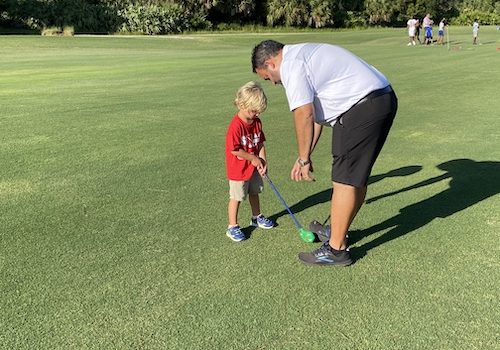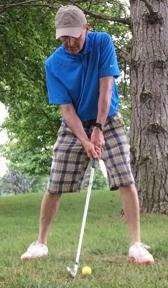
5 Tips to Perfect Your Golf Swing
While good golf posture and grip are essential, so is a proper swing. Golf posture and grip set the foundation for a player’s swing, but a player can determine how far the ball will go based on their swing.
Once golfers have perfected their stance, posture, and grip, they are on their way to learning how to swing. These skills all build off one another, which can help to give golfers a competitive edge on the green.
A good swing is the difference between a shot into a sand trap and a shot on the putting green. Learning how to swing the ball properly can help any golfer take their skills to the next level.
What is a Good Golf Swing?
A good golf swing is any swing that goes where the golfer wants it to go. This swing can be an exact put into the hole or a strong swing toward the putting green. Good golf swings come in all shapes and sizes, making it difficult for new players to adapt.
A good golf swing the following qualities:
- The club’s face aims toward the target
- The ball is between the golfer and the hole
- Swing intensity varies based on distance
- The golfer is appropriately gripping the club
- Proper posture, including slightly bent knees and slightly arched back
There is plenty of work a golfer needs to do before the club comes in contact with the ball. To perform a successful golf swing, the golfer should practice their grip and posture.
Top 5 Tips to Improve Your Golf Swing
There is no textbook solution to perfecting a golf swing. Courses, situations, and clubs vary, meaning that golfers must adapt to these changing conditions to get their swing right.
Every golfer is different, meaning that every swing is also a bit different. Keeping that in mind, we’ve made a list of a few tips that can help any player improve their game. With these tips and plenty of practice, a golfer can get ready for any golf situation.
1. Get Posture and Grip Right
Many students may feel as if they know these fundamental skills already, but it is always good to go back and revisit them. Improper posture and grip can be hard to undo, so the player should correct mistakes as soon as possible.
Issues with grip and posture could impact the direction the ball travels after hit. For example, if the player grips the club too firmly, a golfer’s swing can become too aggressive, which can cause the ball to travel out of bounds.
While revisiting the golf fundamentals might not seem beneficial to players, practicing grip and posture can significantly improve the score. By working on these core golf practices, a player can begin working on their technique.
Posture and grip can help a player:
- Aim the ball
- Develop a consistent play style
- Improve their golf performance
- Create better golf habits
2. Improve Aim
Golf is a complex sport, which can sometimes require mathematical precision to get right. The beauty of a good golf swing allows golfers to visualize the angle the ball is traveling.
The direction a ball will travel is based mainly on the force and angle of the club. These concepts may seem difficult to a new golfer, but they are much easier with practice.
The angle of the club should usually point toward the hole. For more complex swings, this angle can vary, but for now, we will focus on the basic golf swing.
To correctly line the club up with the ball, the club’s face should point in the direction the ball needs to go. Afterward, raise the club and line it up with the ball. The club should be held diagonally above the player’s head, with both hands firmly grasping it.
3. Know How Much Force is Applied
Depending on what situation the player has found themselves in, more or less force is applied when hitting the ball.
The force depends on a variety of factors, including:
- Type of club
- Where the ball should go
- Obstacles in the player’s path
- Position on the course
For example, if a player has found themselves stuck in a sand trap, we recommend using plenty of force to chip the ball out. Hitting the ball too lightly could result in the player getting stuck in the trap for another turn.
This tip also applies to the putting green. It might seem exciting to try to hit the ball in as fast as possible, but it could cause it to travel off the green. Players must distinguish when they should hit a ball soft or hard.
This distinction could give players an edge on the green, allowing them to improve their score and overall performance.
4. Learn From a Professional
Having an instructor or mentor can also help the practicing student. By having a teacher demonstrate proper swing methods, a student ensures that they are learning the correct position and technique.
A teacher can help a student improve their score, all while demonstrating accurate methods for improving swing. Most teachers and mentors have had plenty of time on the green to practice, meaning that their advice is logical.
Students learning from a teacher should apply this advice for their success on the course. Players can always consult teachers for strategies and tips on the field; they have usually experienced what their students are going through.
5. Practice!
Practicing swing can help a golfer get a good idea of where the ball is going to travel. By consistently practicing, a student can learn how hard they need to hit the ball to go in a particular direction.
For players looking to perfect their swing, we recommend going to the green. A golfer can learn what needs to improve regarding their swing by hitting a few balls on the course.
It is one thing to read about developing a good golf swing and another to apply the advice. By practicing, learners are solidifying these new skills for future use.
Learn More With Indian River Golf Foundation
If you’re excited to get on the course and perfect your swing, contact the Indian River Golf Foundation. We would love to help you tee up!
If you have any questions about our organization or any of our programs, feel free to reach out at (772) 713-9593 or reach out via email.




This Post Has 0 Comments